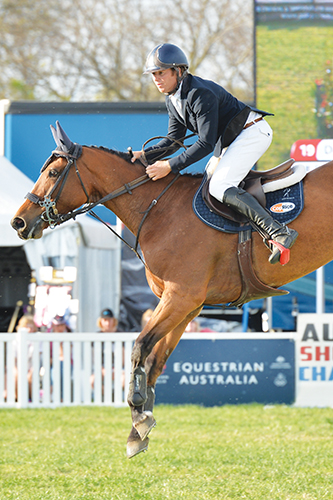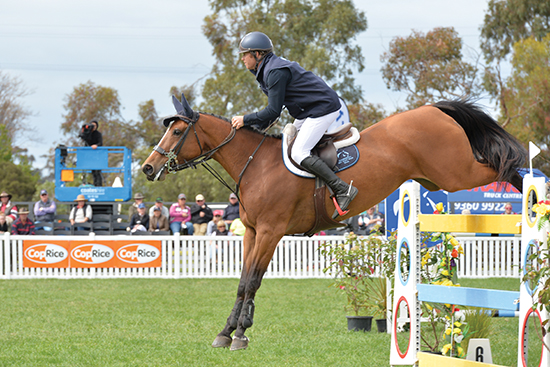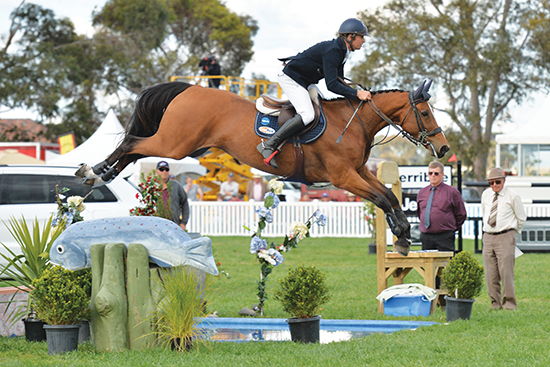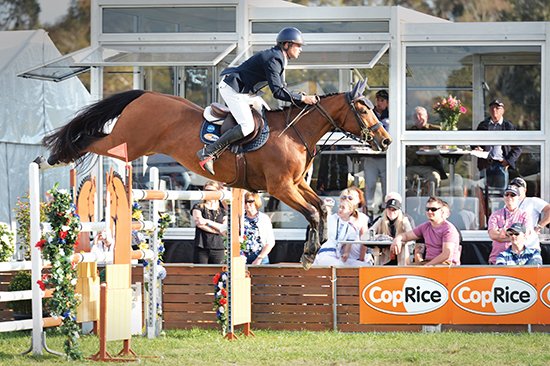When you were in primary school and all the other kids wanted to grow up and be stockbrokers or the captain of the Aussie Cricket team, you always wanted to be a showjumper?
“I think I always did want to be a showjumping rider. I tried to be a footballer before that but I think I always wanted to be a showjumper. I’m a showjumping tragic, I read old the stories from years ago, it is not just doing the sport, I love the sport.”
A family thing?
“Yeah, my parents both rode, my mum is a dressage rider, my dad showjumped quite a lot, my aunty showjumped and dressaged. It’s quite a successful horse family, my grandfather was right into the coaching, he made the syllabus for the level one coaching, so horses have been in my family for years.”
Who were the people who shaped your riding?
“Definitely my parents, they were very good at keeping my brother and I grounded. We rode a lot of young horses, they really believed that you had to learn how to make horses, anyway we couldn’t go out and buy them ready made.”
“I was very lucky when I was a kid, Jenelle Waters, she taught me a lot, put a lot of time into us for nothing, just because she was interested. Others like Lindsay Ball, Grant Hughes is another who helped me for years. There were plenty of other top riders along the way. In Australia we are very lucky, our top riders are very open and ready to help – George Sanna, Vicki Roycroft, Jamie Coman is another, anyone who would lend a hand, we are very lucky like that.”
Were you a star junior rider?
“I did win a fair bit in Juniors, I won in Sydney and Melbourne, but I wasn’t a Tom McDermott, I didn’t dominate that’s for sure. We probably rode some tricky horses when I was a Junior and in Young Riders, but I think that helped me a lot later on. It also helped me to understand the sport, and understand that some days things go well, and some days they don’t, and you just make the most of the good days and know how to turn around from the bad days.”
What was the first really good horse?
“I had a horse when I was just out of Juniors, Chrome, by Kassiber, and he was my first Grand Prix / World Cup horse. He was a bit tricky, that’s how I got him, he used to hump up a bit – but he was a fantastic horse, very brave, very scopey, he was a great horse for my first Grand Prix horse, and I was very lucky to have him. He’s still at home in Forbes at my parents place, he babysits all the foals, I think he is 25, he still looks pretty good, and he’d still hump up if anyone got on him…”
How did you get the ride on the mare, RR Dyranta?
“I started to have a bit to do with the Martin family when they moved out to Wilberforce, where we are. Bonnie had a fair few to ride, so I started riding the Bellarose mare, Dyranta’s full-sister, and that was quite successful. Then when Bonnie was pregnant, I got the ride on her other horses and one of those was Dyranta. She was a C grader, had done some Futurities with Bonnie, and Bonnie had started her in her first Grand Prix at Gunnedah. We had a great partnership, I won a Mini Prix on her, then she went back to Bonnie for a while, then things got a bit busy with Bonnie and her family, so I had the ride again. It was mainly for last year’s Sydney Royal, we had a really good show, she was leading Part 2 horse, we did the World Cup at SIEC after that, and the rest is history. She won the Australian titles last year, she’s won three World Cups now. Leading Part 1 at Sydney just gone… it has been a fantastic 18 months.”
You were saying that when you started you didn’t think she had the scope…
“She is a very careful, and very competitive, she has been competitive through all the grades but she didn’t have the best natural canter – it did feel when the jumps got a little bit bigger that she didn’t have the power or scope, I really thought she’d jump Mini Prix, and I would get a World Cup out of her but I didn’t think she was going to be as good as what she has become. We’ve just kept training the way we want to train her, we had a plan for the horse, and she has just got better and better, and now she feels quite comfortable over those bigger tracks.”
When you have a canter problem do you pay a lot of attention to your flatwork?
“Totally, with her, she fundamentally wasn’t very good at cantering so we had to start right at the beginning with her. A lot of lateral work in the canter, a lot of counter canter. Flying changes were another thing she didn’t find very natural – we’ve really had to start back, even though she was jumping World Cups, we sort of trained her like she was a five year old, and a lot of the credit for that goes to my partner, Tallara. We have a joint plan with all our horses, Tallara rode her for six weeks leading up to Sydney Royal, really just concentrating on her flatwork, and that was part of a plan, earlier in the year, we really wanted to get her stronger over the back and better in canter.”
“A lot of that I also have to attribute to Tony Norman who is our trainer at home. Tony is there every day and gives us a hand with pretty well every horse we ride. He watches her all the time in the ring, and sees her at home, and he is a huge help.”
“The other person is David Dobson, David comes over five or six times a year for two days of intensive lessons. Normally I’ll have lessons on six horses, and he helps formulate a plan for the next couple of months.”
You still like it, you are not sad you didn’t become an airline pilot or a school teacher…
“I was a teacher, I taught at Parkes High for four years. My last year of teaching was 2008, and I quite enjoyed it but I love training horses, that’s my passion. I’m pretty excited about what the future has in store.”
I saw you a few weeks ago in Germany and you were on your way to the Glock Show, is it a bit depressing to get back here with shows in the backblocks?
“I don’t find it depressing, I still love Australian showjumping, and in the last ten years it has improved so much. It is getting stronger and stronger, in another ten years who knows where we will be with the quality of shows and horses over here. We’ve been overseas the last two years, and been to some shows, tried some horses, and each time it has been a great development for us as professional riders, when you come back, you are that bit more inspired.”
“You watch hard when you are over there. We spend a lot of time in the warm up watching all the top riders and listening to what they have to say. Every time there are new ideas, different trends, and we’ve done that last year and this year in the month prior to the Australian titles, and I really think that has been a big part of winning the titles.”
“Going this year to Aachen and the European Championships and watching how they prepare their horses for a Championship, what they do on the first day, the second day, that was a big part of winning at Werribee this year.”
I was a bit amazed coming to Werribee from Aachen, that a lot of the horses looked fat compared to the horses in Europe – are our riders up on the degree of fitness work those European riders do with their horses?
“I don’t think they are to be honest. I don’t think we are as good at maintaining our horses and preparing them for an event, I think we can learn a lot from the Europeans. At the end of the day it is about being a really good horseman, to bring your horse out to perform three days out of four and stay performing and get better throughout the show, it takes a bit of planning.”
When we were at Marco Kutscher and Eva Bitter’s they were riding their horses out in the forest, I don’t know if many of our riders do that sort of work…
“It depends a lot on where you live. Dyranta lives at River Ridge, at the Martin’s place, and part of her training program is trotting up the hills, so she does hill work at least once, if not twice, a week. When I first got her, she didn’t have a very good fitness base, so we did a lot of water walking with her – now we don’t water walk her because that brought her base level fitness up and made her stronger over the back, now she is going better on the flat we can maintain that with the flatwork, but we do a lot of hills.”
“Where I grew up at Forbes, we used to ride our young horses out in the paddocks, through the puddles, ditches, up the dam and all those sorts of things. Where we live now at Redleaf in Wilberforce, we can do that because we live on dirt roads, we ride our horses up the roads at least once a week. All our breakers and young horses go up the road, they don’t see an arena until they are four. We’ve got a good cross country paddock and we use that. Christine Bates’ place is walking distance from our place, so in the leadup to the Australian Champs, twice a week, all our horses went up and did hills there. If it is accessible, you can do that work, if it’s not, it is a bit hard to do.”
George Morris described you as having ‘great feel’ – how did you develop that quality?
“I think just riding heaps and heaps of horses. I’ve always been lucky, I’ve always ridden lots of different horses – hot horses, cold horses, big horses, small horses. Where I want to be a lot better is I want a better position. That’s my biggest fault, I don’t have a good enough position. You go over to Europe and we can say they have better horses than us, which they do, but at the end of the day they are better riders than us. You go into the warmup there, you think, I need to put my elbows by my side, push my heels down, because you are the only one that’s not. That’s why it is great having someone like Tony Norman around, he’s forever walking past me in the arena, and saying, I think you need to do five minutes without stirrups. That’s part of the trouble, we ride a lot of horses that we have to, just dealing horses or whatever, and often we are just thinking of getting the job done without thinking about our riding. It’s very important every day we get up, we think about what we are trying to do, and that’s become better athletes and train better.”
You breed a few of your own?
“Tallara and I breed two or three a year. We foal them down in Sydney but when we wean them, I send them to Mum and Dad’s at Forbes and they live there until they are two, then we bring them back and break them in. It is the best place for them to grow up, out there, Mum and Dad really look after them, they grow up on rye grass and oats, and when they come back to Sydney they are a hand higher than all the other young horses, they have a top line, and it is really good for their feet, and that carries on through their legs, so we tend to have no soundness issues. That’s a really good setup, and as long as Mum and Dad are happy to keep looking after them, I’ll keep doing it.”
What are your favorite bloodlines?
“We are very lucky, we bought a mare from Lesley Hargreaves, four years ago, a Quidam mare, Holland Rose. She was the dam of Cadiz, Tallara’s good horse, Copabella Verdi, and the horse Brooke Campbell won the Futurity on, Copabella Voltage. We have three foals out of her, and two due this year. We’ve used some overseas semen, but I do like using some Australian stallions that I have actually seen, I think that’s important. The only problem about using the imported semen is that you can see them jump one round, but you can’t see them all the time, on the showgrounds, in the warmup. We’ve used Lux, we’ve used Quincy, used Carpino, we have a couple of Visages, Conquistador – I’m a really big fan of Conquistador. I’d prefer to use stallions that I have seen and know.”
Is Rio too early for you and Dyranta?
“Aaaah… what we are looking to do is take the horse overseas and do a European campaign. Start her at some shows and just see how we go. Who knows? We’ll set up a plan and part of that plan will be going to some smaller level shows over there, hopefully getting picked on a Nations Cup team and if she performs well at Nations Cup level, then I’d be saying, she’s definitely ready. If she doesn’t, and she may not be ready, that’s horses. I’m not going to say, I’m definitely going to Rio – I haven’t been there, done that, she hasn’t competed over there. Saying that, she’s a fighter and she’ll keep trying, keep getting better, and we’ll give her every chance. If she does the performances and is lucky enough to be selected, I do think she’ll do her best, and I don’t think she’ll disappoint.”
Dave would like to thank his sponsors: Coprice, Antares Australia, CF Equestrian Style, BSMsport, Horseland Dural, Freejump, and Nature Vet.
Each Rider of the Month receives a prize supplied by IAHP.
This month, the Rider of the Month receives a 30g Protexin Paste valued at $21.60.





